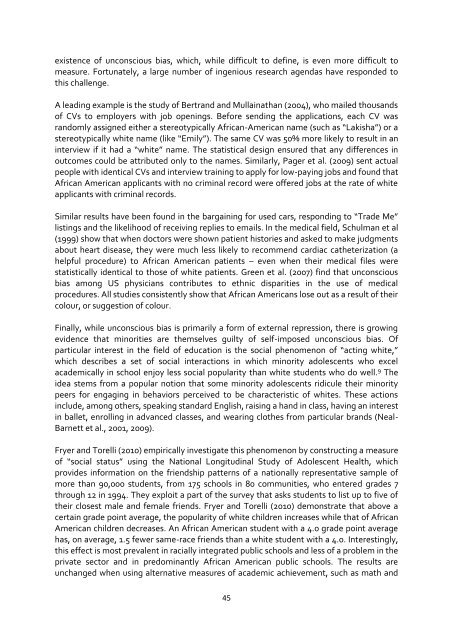UNCONSCIOUS BIAS AND EDUCATION
unconsious-bias-and-education
unconsious-bias-and-education
You also want an ePaper? Increase the reach of your titles
YUMPU automatically turns print PDFs into web optimized ePapers that Google loves.
existence of unconscious bias, which, while difficult to define, is even more difficult to<br />
measure. Fortunately, a large number of ingenious research agendas have responded to<br />
this challenge.<br />
A leading example is the study of Bertrand and Mullainathan (2004), who mailed thousands<br />
of CVs to employers with job openings. Before sending the applications, each CV was<br />
randomly assigned either a stereotypically African-American name (such as “Lakisha”) or a<br />
stereotypically white name (like “Emily”). The same CV was 50% more likely to result in an<br />
interview if it had a “white” name. The statistical design ensured that any differences in<br />
outcomes could be attributed only to the names. Similarly, Pager et al. (2009) sent actual<br />
people with identical CVs and interview training to apply for low-paying jobs and found that<br />
African American applicants with no criminal record were offered jobs at the rate of white<br />
applicants with criminal records.<br />
Similar results have been found in the bargaining for used cars, responding to “Trade Me”<br />
listings and the likelihood of receiving replies to emails. In the medical field, Schulman et al<br />
(1999) show that when doctors were shown patient histories and asked to make judgments<br />
about heart disease, they were much less likely to recommend cardiac catheterization (a<br />
helpful procedure) to African American patients – even when their medical files were<br />
statistically identical to those of white patients. Green et al. (2007) find that unconscious<br />
bias among US physicians contributes to ethnic disparities in the use of medical<br />
procedures. All studies consistently show that African Americans lose out as a result of their<br />
colour, or suggestion of colour.<br />
Finally, while unconscious bias is primarily a form of external repression, there is growing<br />
evidence that minorities are themselves guilty of self-imposed unconscious bias. Of<br />
particular interest in the field of education is the social phenomenon of “acting white,”<br />
which describes a set of social interactions in which minority adolescents who excel<br />
academically in school enjoy less social popularity than white students who do well. 9 The<br />
idea stems from a popular notion that some minority adolescents ridicule their minority<br />
peers for engaging in behaviors perceived to be characteristic of whites. These actions<br />
include, among others, speaking standard English, raising a hand in class, having an interest<br />
in ballet, enrolling in advanced classes, and wearing clothes from particular brands (Neal-<br />
Barnett et al., 2001, 2009).<br />
Fryer and Torelli (2010) empirically investigate this phenomenon by constructing a measure<br />
of “social status” using the National Longitudinal Study of Adolescent Health, which<br />
provides information on the friendship patterns of a nationally representative sample of<br />
more than 90,000 students, from 175 schools in 80 communities, who entered grades 7<br />
through 12 in 1994. They exploit a part of the survey that asks students to list up to five of<br />
their closest male and female friends. Fryer and Torelli (2010) demonstrate that above a<br />
certain grade point average, the popularity of white children increases while that of African<br />
American children decreases. An African American student with a 4.0 grade point average<br />
has, on average, 1.5 fewer same-race friends than a white student with a 4.0. Interestingly,<br />
this effect is most prevalent in racially integrated public schools and less of a problem in the<br />
private sector and in predominantly African American public schools. The results are<br />
unchanged when using alternative measures of academic achievement, such as math and<br />
45


